Connected, but lonely.
The Internet was supposed to make the world more open and connected. Yet, trillions of friend requests later, we’ve never felt more isolated. The latest stats are heartbreaking: 60% of Americans are lonely. As disturbing as it may be, what used to primarily be an issue for seniors is now spread over all generations: The younger you are, the more likely you are now to feel lonely.
Loneliness isn’t just making us unhappy, it’s silently killing us: Social isolation is as harmful as smoking 15 cigarettes a day. If the situation is so critical, why aren’t we doing more to fix it? Because we’ve been collectively ashamed to talk about loneliness. Our silence has incubated one of the most insidious crises our society has to face. It’s time to act, but how?
I believe in technology and entrepreneurship to solve the world’s biggest problems. For the past couple of years, I’ve witnessed an uprising in startups waging a war on loneliness, COVID acting as a catalyst. In this article, I’ll cover 160+ companies leveraging AI, gaming, dating, and more to solve loneliness at scale, all sharing one core belief: Technology can help us belong.
Before we jump into what I believe will be a tidal shift in consumer habits and startup investment, let’s hit reverse for a sec to piece together the backstory. How did we get here?
Technology and the individual.
Throughout history, we’ve always been part of something greater than ourselves. A religion, a family, a village—belonging wasn’t something we chose but something we needed: It was impossible to survive as an individual. But belonging came at a cost: Dependency and lack of agency. As a result, a few institutions dominated our everyday existence, sometimes preventing us from becoming the architects of our own lives.
As technological progress advanced, the balance of power shifted: It used to take a village to raise a kid; it now takes an iPhone with an internet connection. The more leverage we have as individuals, the less dependence we have on others. We've been sacrificing human connection for years—transacting things that traditionally had to be done by someone who cared about us. Uber instead of our parents picking us up from the airport, Doordash instead of cooking with our roommates, and TikTok instead of hanging out with our friends.
Technology makes our lives easier. Convenience has, however, come at a cost.
We are free, independent, and sovereign.
But we are lonely…
It’s time to belong.
Yesterday, we were born as part of a community and had to find our way as individuals. Today, we are born as individuals, free to find our community. We have every reason to celebrate this new-found individual autonomy & freedom of choice. But if everything is going so well, why are we so addicted, stressed, and depressed?
In my opinion, loneliness is the root cause of our mental health crisis. Loneliness is now one of the most important problems our generation has to solve, alongside climate change and obesity. It’s time to find a balance between individualism and collectivism, between solitude and solidarity, between independence and interdependence. It’s time to remember that as individuals, we are the beginning but not the end. It’s time to belong, again.
This leads me to the central question of this article: How can technology help us belong? It’s very easy to blame technology for our loneliness and want less of it. But it’s important to remember that technology follows ideology, not the opposite. We’ve built our modern world on the dream of individual autonomy, and technology made it a reality. We are now wishing to become part of something bigger than ourselves, again. I believe technology will answer this call too.
Fortunately, it has already started. Hundreds of companies are addressing loneliness, building products and services to help us belong. In this article, I’ve decided to cast a well-deserved light on 160 of them, ranked under six core institutions that traditionally provided us with a sense of belonging: Religion, Family, Neighborhood, Friend Group, Couple & Company. Hopefully, this inspires a few entrepreneurs to start building in this direction.
Let’s dive in.
1. Religion
Religion is the meta of all institutions. Its place has been historically so central to our society that it became its operating system. Through its complex rituals, religion traditionally orchestrated many of our social interactions and incentivized our altruism. It’s a secret to no one: we’re losing religion. Church membership recently fell below 50% for the first time in history, and many of us are left alone to explore our new selves without any churchgoer, priest, or God to talk about it.
Nature abhors a vacuum; the mind does too. So, we’re slowly replacing religion with weaker forms of cults: 30% of U.S. adults already consider themselves as spiritual but not religious.
Unbundling religion can be a very wide trend and can also encompass categories like Psychedelics, Yoga, Meditation, Activism or Fasting apps. We could even frame the rise of the Creators as part of this unbundling since creators are becoming the new priests. But I’ve decided to focus on just a few sub-categories replacing the social aspect of religion rather than the ritualistic or transcendental aspect.
Alcoholic Anonymous for X: AA is one of the first successful unbundling of religion, despite using a secular yet quite spiritual framework. Group therapy has since 1) expanded to other verticals and 2) massively moved online. HumansAnon, Circles, YoniCircle, and SunnySide are connecting groups of people through audio spaces to find support & belonging. This could be seen as an unbundling of Reddit & Clubhouse and a smart approach to build vertical social networks with the optionality to evolve into full-stack mental-health social memberships like Real or social wellness platforms like BlueFever and Wisdo.
Astrology: Astrology is benefiting from the unbundling of spirituality from religion and is projected to reach $22.8B in 2031 (they probably also used astrology for the prediction). Inherently social astrology apps like Co-Star have been downloaded by a quarter of all women aged 18–25 in the US, followed by others like ThePattern or Sanctuary. Social Tarot platform Moonlight is bringing card reading online through interactive rooms.
From fitness to wellness clubs: People are turning to fitness classes for meaning, ritual & community. Brands like SoulCycle and CrossFit and Barry’s have scaled belonging, and the parallels with churches are striking. New companies like Othership are going above pure fitness and expanding their social-bathhouse concept leveraging a deep sense of belonging to drive retention. The social wellness trend is going strong, with players like Peoplehood and Remedy Place leading the charge.
Daily Prayer apps: Let's not bury religion just yet. God used to be the ultimate scalable friend, and even if daily prayer apps are not social, they ultimately connect us to something greater than ourselves. Religious apps have received $175M in 2021 alone, still a long way from their secular meditation/mindfulness counterparts Calm and Headspace. Christian apps Glorify and Pray and Catholic app Hallow both raised dozens of millions from top VCs and Muslim app Guider is following the trend. We’re also starting to see religious/meditation hybrid apps like Ritual.
2. Family
In the past century, we have experienced what is perhaps the most rapid and significant transformation in family structures in human history. Transitioning from extended families to nuclear ones and eventually to blended families has consequences: In the past 40 years, the size of families shrunk massively. The number of households composed of married couples with children and households consisting of 5+ individuals both decreased by 50%.
Smaller family, less support, more loneliness. So what replaced the help once provided by extended family (especially women), like child care, babysitting, tutoring, and emotional support? Paid services. Wealthy parents can afford these expensive resources to support their children's growth and keep their marriages strong, but lower-income families often cannot. Technology is lowering the costs of these services, making them affordable to as many people as possible.
I won't discuss healthcare in this section, but rather focus on services that traditionally had to be done by family members.
Loneliness-focused elderly care: Lonely people are 50% more likely to die prematurely than those with healthy social relationships. While elderly care has rightfully mainly been focused on providing health care and home care, a new breed of companies have started tackling loneliness and social isolation among seniors. Miami-based Papa is matching aging seniors with college students and has raised $250M in less than 5 years. Element3, JoyClub and Hank focus on match-making seniors around hobbies & activities. Zoog & Remento are bringing generations together around storytelling. Aidaly is helping family caregivers to get paid for their support. And lastly, Elliq, Cutii & Rendever are respectively building robots & VR solutions to fight seniors’ isolation.
FamilyTech: 90% of new moms experienced loneliness after giving birth, and more than half (54%) felt like they had no friends. It takes a village to raise a child, but nowadays, many families face this challenge in isolation. There are new ways for them to share that burden: From women-centered communities (Tinto, WeMoms, Peanut) to parenting-expert marketplaces/memberships (Cleo, Bloss, Mahmee) or parenting circles (Guardians Collective, Oath), raising children isn’t a single-player game anymore. AI is also getting involved: Milo is developing a GPT4-powered co-pilot for parents. Even child-care (Otter, Winnie, Kinside) and taking kids to school (Zum & HopSkipDrive) can become tech-enabled. And when things are not going as expected, co-parents can rely on apps like Onwards and CoParenter and even single-parent co-living like Commune and CoAbode to make their life easier.
3. Neighborhood & Third Places
Neighborhoods have traditionally been a cornerstone of social wellbeing. Everyday encounters are amazing for our mental health, yet they are becoming increasingly rare. As living conditions continuously improved, we’ve replaced hanging out with strangers at the local bar with watching a movie on Netflix and ordering dinner on Uber Eats. So much so that today only 25% of people living in urban areas actually socialize with strangers at least once a week. We don’t really need our neighbors for either entertainment or support, so we never really get to know them. Plus, people are churning out of neighborhoods very quickly as the average tenancy in big cities like London has dropped to about 20 months. So, why bother?
The concepts of Neighborhood and Third Places (more on that below) are being reinvented and pulled away from their previous offline-only definition. Social compatibility is less and less limited by physical constraints, so we’re slowly trading local generic communities for global niche ones. In other words, we might have more in common with someone living far away than with our neighbors, so why limit ourselves? The Internet (especially with AI) is becoming this massive match-making machine where relationships start online and are bridged offline.
This URL-to-IRL cross-over has barely started and we undoubtedly need both forms of Neighborhood and Third Places in our lives. A few trends:
Home ownership: Belonging to a neighborhood is a big function of home ownership. Unfortunately, renters now outnumber homeowners in large cities like London, causing people to relocate regularly as rent continuously increases. That’s where rent-to-own companies enter. Divy, HomePartners (acq. by Blackstone for $6B), Landis, Utopia Homes, Up&Up, Belong (funny name, huh?) are all helping renters build ownership and hopefully anchor themselves longer in their local community. Another trend worth mentioning is fractional ownership going social, with Fractional and Nestment letting you co-own real estate with friends and Fractal, Ember, Seqoon, Kocomo enabling shared ownership of second homes.
Co-living: Renters can still create deeper bonds with their neighbors through co-living. Although the trend hasn’t delivered on all its promises (thanks, WeWork/Live), demand from millennials is still very strong, fueled by the rising cost of living in big cities. While the early days of coliving saw a burgeoning of new companies, the difficulty in scaling the model has recently led to market consolidation: Co-living giant Habyt has acquired 7 of its competitors and now boasts 30,000 units across 40 cities. Through consolidation, the co-living market is also diversifying into niches. From lonely seniors with Colette to traveling Gen-Z with Selina to older but still active individuals, the market is proving Jack Johnson right: “It’s always better when we’re together”.
Social Gaming: Sociologist Ray Oldenburg defines "Third Places" as meeting spaces outside of home and work, where conversation is the main activity. Sure, you can think of bars, cafés, churches and clubs, but if you’re in your 30s like me (which means you’re not old YET, ok?) you might remember MSN, Myspace, and even early Facebook as such places. Now, If you’re in your 20s, you’d probably think of Minecraft, GTA5 RP and Fortnite as your Third Places. If you’re a teenager, Roblox and Rec Room would be your hangouts. Gaming is eating the (Third Place) world, and founders are now building social-first 3D experiences for people to connect around. Bunch and Rooms are building the new 3D hang-outs. Game studio ThoseBeyond believes “the next global IP is not just entertainment, but a culture of belonging”. Gardens is building “living worlds that bring players together to cultivate lasting friendships”. HeroJourneyClub provides mental health support while gaming. Finally, VR company Unison builds its hardware & software with social interactions as its core value prop. Considering that 67% of all teen boys ages 13 to 17 play video games over the internet with friends weekly, social gaming might be the future of Third Places.
Hybrids: 3% of boomers met their closest friend online vs. almost 40% for millennials and Gen-Z. Friendships are now starting URL and moving IRL (more on that later), and a new breed of Third Places are following the same movement. BuildSpace is creating a new-gen online school for builders and is opening IRL hubs for its alumni to hangout and build from. SuperTeam is doing the same for Solana-builders. Even new members-only clubs like Chief—with 20k women in its network—have opened exclusive clubhouses in 4 US cities. It’s not crazy to think that successful online-first communities using Circle and Nas would at some point open Third Places and turn into members-only clubs? Especially relevant now, knowing that almost 20% of UK public libraries have closed in the past 10 years. The future of Vertical Social Networks may lie offline too.
4. Friendships
The last decade has seen the most rapid escalation in the quest for attention. Content Marketplaces (or Social Networks as they used to be called) progressively expanded the competition for attention from your friends, to your friends of friends, to anyone in the world. This enabled some talented individuals—the creators— to scale their reach like never before: They became our always-available parasocial friends. Mukbangs creators turned into our lunch buddies, creator collectives like David Dobrick’s became our extended friend groups, and vloggers like Emma Chamberlain our confidants. Some of us even watch them sleep. But in the meantime, Americans started having fewer friends than they used to: 15% of men have no close friends in 2021, a 5x increase from 1990.
Why is that? First, content marketplaces like TikTok and YouTube became so efficient, they’re now providing us with extra-personalised niche content. So much so that 55% of Gen-Z agree that they watch content that no one they know personally is interested in. We used to watch the same TV-shows, but now everyone’s TikTok feed is different. We now belong to horizontal non-geographic ephemeral niche communities (e.g. anime fans), which makes us sometimes feel locally inadequate. In other words, we all have our content kinks that we don’t often share with our friends. But that’s not it. A second reason might be that we’re becoming lousy friends to each other. How so? Well, as average screen time grew 3x from 2008, we’re now spending—on average—more than 7h a day on screens. Friendships require undivided attention that we don’t give anymore. So, instead, we’re turning to creators and AIs more.
Meet new people online: In less than 20 years, we went from slow content (TV, Radio, Newspaper) to fast content (YouTube) and superfast content (TikTok). In parallel, the same happened in commerce: From slow commerce (retail stores with 12 months cycles) to fast commerce like Zara (3 weeks) and then superfast commerce like Shein (3 days). But at the community level, we’re still stuck at 1st gear: Slow communities like religion, family or neighborhood can’t evolve as fast as what we’re watching or buying. Belonging needs to be more fluid too, and companies like Yubo, Jodel, Wink, Wizz, Fam, Maven and LMK are helping millions of individuals explore new interest-based friendships that start online. Naval’s new company Airchat is pitched as “a dinner party in your pocket” and promises to help us “never feel alone again”. Sincerely built a safe place to help its users get things off their chest and help others. Even book clubs that have traditionally been a great way to meet new people based on shared interest are moving online with Fable and Bookshelved.
Online to offline: Let’s not lie to ourselves: Online communities are great, but the most accurate measure of loneliness is what you’re doing IRL on a Saturday evening. We’re as happy as the quality of the relationships we have with the people closest to us, and these relationships mainly deepen in-person. Sadly, young people are hanging out face-to-face less often, and this drop ties into feelings of loneliness. This is a tough nut to crack—the URL to IRL space is such a gigantic startup graveyard that it became a meme. Maybe this time will be different? I believe it will, as meeting friends online is now crossing the chasm, just like meeting lovers online did a decade ago. Meetup has been a pioneer and remains the leader in terms of user engagement, but competition is beginning to intensify. As a result, former online-community platform Geneva is building upon a recent surge in running and book clubs and defines itself as the “online place to find your offline people”, similar to Dive Chat focused on “Making moments happen”. Social calendar apps Howbout and Saturn are taking a utility-first approach to help friends & students schedule more face-time together, respectively. What about eating together? You can meet new people for breakfast with The Breakfast, for lunch with LunchClub and for dinner with 222. Or take-out with friends on Snackpass. Even ticketing & event platforms FeverUp, Dice and Partiful have all identified loneliness as the main issue they're working to address. Social traveling company Dharma turns creators into travel agents at scale and matches like-minded people with travel experiences they compare to “secular pilgrimages” and WeRoad promises you won’t have to travel alone again.
Close Friends apps: Social media was meant to be a place where we share things with our friends, but it quickly turned into a place where we just show (off). Ten years ago, I wrote about this difference and about my (failed) efforts to use Path more than Facebook at that time. Path was the first app dedicated to your close friends, and was probably way ahead of its time. But I’d argue that tackling the challenges of abundance may soon surpass addressing those of scarcity. While the 2010s were about making as many friends as possible, the 2020s could be about forming deeper and better connections with your closest friends. No wonder we’ve seen a resurgence of apps like BeReal, Locket, Vibes, Sush, Lobby and more recently Retro, products focused more on sharing than showing, more on belonging than status.
AI Friends: With the introduction of GPT-4, AI became human-level or better at many tasks, and one of them could be friendship. This is not surprising considering that we’re becoming subpar friends with our attention spans having shrunk 25% from 2000 to 2015. If people are given the option of either extreme loneliness, a lousy friend who doesn’t listen, or a thoughtful relationship with an AI, they’re going to choose the later most of the time. That’s the opportunity that companies like Replika, Character.ai and Chai are seizing, providing text-based AI companions to millions of people already. Ava (testflight only) is going one step further with a voice-first and a 3D-animated experience. Inworld and Convai are building a platform for any game developers to bring their NPCs to life. AI companions might take an increased size of our social life, but they also might help us connect with one another better, like Amorai’s AI relationship coaching app built to help us foster real-world relationships or Circle Labs building the AI spirit animal of a community, strengthening its members’ feeling of belonging. Friendship isn’t a zero-sum game, and just like we’ve developed friendships with pets, we’ll also develop new ones with AIs.
5. Couple
Over the past century, many institutions that provided us with a sense of belonging have eroded, leaving romantic relationships as one of the last pillars we can lean on. Slowly but surely, the couple took most of the pressure that was once shared by these crumbling institutions, and it’s heavy. We’re now expecting our couple to be everything we’ve lost: A family member, a best friend, a lover, a thought partner, etc. We want it all, in one person.
In parallel, the advent of online dating brought us near-infinite choices which triggers Option Paralysis: The more choices we have, the harder it is to make a decision and the more unsatisfied we become. Online dating also removed geographical constraints, which used to protect the average from the best. In other words, 10% of men get 60% of all matches and the bottom 50% of men combined only receive 1% of the total likes. If Tinder was its own economy, it would be more unequal than nearly 96% of all countries.
Combine these two phenomena, and you no longer need to wonder where all the lonely people come from. There seems to be a form of resignation since now 60% of single adults in the U.S. say they are not looking for a relationship or dates. This situation is not inevitable and we're not going to leave it at that. Like French poet Serge Gainsbourg sang, “la vie ne vaut d’être vécue sans amour”, so what’s new under the romantic sun?
Post-swipe dating apps: The days of photo-based online dating apps may be numbered. People are actively looking for new experiences that are more social, inclusive, and immersive. Feels, Ditto and IRLY have bet on a video-first experience, Thursday & 222 have taken an offline-first approach and new companies like Doubble, Wingr & Yidui are making dating more social involving match-makers or friends in the process. AI is also entering the dance, with new AI dating assistants Rizz, Keys and YourMove helping you write that perfect catchphrase. Replika is going one step further and announced Blush, an AI-dating simulator. We’re entering a post-swipe era and lots of new companies are poised to revamp romance in the coming years.
Tech-enabled couples: We’re not usually single because we never found anyone, but because we couldn’t make a relationship work. The days of lifelong relationships might be over, but that doesn’t mean we can’t try harder and better. A new breed of companies are betting that technology could help us extend the average relationship length to more than what it is right now. Paired, Blueheart, Relish, Flamme and Official (acquired by Bumble) have built “relationship care” apps for couples, Lasting, Ritual & Lover are democratizing couple therapy, and on an adjacent note, HoneyDue is helping couples manage their money together. The beginning of a new CoupleTech category?
Online Girlfriends: Over 60% of men under 30 are now single, and 30% of them haven’t had sex in the past year, a 3x increase in 10 years. The phenomenon of romantic loneliness seems to be more prevalent in men than in women, with men actively seeking solutions on the internet. The rise of Onlyfans can be interpreted as a “commodification of intimacy” where, unlike porn, adult creators can now provide lonely men intimacy at scale over DMs. But true infinite scale is now possible with ChatGPT-enabled chatbots trained on a creator’s content. That’s what Forever Companion is pioneering with Caryn.ai, its first influencer turned into AI. Alphazria provides uncensored roleplay with an AI and its UVP is to ‘say goodbye to loneliness”. DreamGF helps you create your AI girlfriend and is already making 100K+ per month. Remember that scene in the movie Her where Theodore realizes that Samantha is talking to 8,316 people at the same time? Well, it’s happening now and I believe lots of men will find more companionship chatting with AI than being ghosted by 99% of their Tinder match after two sentences. The Simp Economy has only just started.
6. Company
For many people, the company is often the last standing pillar of belonging and socialisation. Activities like having lunch with colleagues, attending a co-worker's farewell drinks, or going to the company’s Christmas party are some of the few remnants of what was once a vibrant social life for many millennials. Unfortunately, as employment no longer offers the social and economic security it once did, employees are feeling lonelier than ever. And it makes sense: Why attach your identity and community to a company if you change jobs every few years? Consequently, new generations are rejecting traditional career paths and roll their eyes when pitched to join “the *insert company name* Family”.
As a result, 76% of Millennials and Gen Zs want to be their own boss—and America will become a freelance-majority workforce in 2027. The next generation is massively going independent and they have new dreams: More American kids want to become YouTubers than astronauts. Becoming a creator is the climax of independence for an individual: One person, one camera, one empire. Of course Gen-Z’s new entrepreneurial mindset is to be celebrated, but we need to be aware of the downsides. Indeed, becoming a solo-preneur, a freelancer or a creator comes at a (high) price: Loneliness.
How can we provide a sense of belonging in the workplace, either as an employee or an independent?
Team Building 2.0: Feeling like you belong doesn’t just make you happier but also more productive. Indeed, employees that have a best friend at work will be twice as engaged. Unfortunately, going remote has alienated and isolated many people and broken down many groups of colleagues. Work is going hybrid, but is team building also following? That’s what companies like Jurnee and FiveToNine are betting on by building all-in-one business events platforms to easily re-engage employees. Another approach to the problem is Teamaraderie, which is building a B2B MasterClass-style platform to foster belonging in the workplace, or Intros, which is automating introductions between members of the same company/community.
Mentorship: We used to benefit from a wide support network where relatives and longtime friends would act as coaches, mentors or role models. As these networks grew weaker, the workplace took over that supportive role, and the manager became a part-time amateur (clumsy) psychologist. We’re now witnessing an unbundling of mentorship from management, where employees, freelancers and entrepreneurs altogether are seeking external help to support their personal & professional growth. Surfing this trend, companies like BetterUp, CoachHub and Torch are building people development platforms for companies to deliver coaching programs to their employees. Wave is going the tech-enabled approach to democratize executive coaching by building a text-based experience for an affordable price.
Virtual workspace: As remote ate the corporate world during COVID, we realized that the office meant more than just long commutes, cubicles and bright white lights. The “In Person” workspace experience also brings belonging, accountability & serendipity. In the great unbundling of work series, how can you keep the “In Person” upsides without the downsides? That’s what companies like Flown and FocusMate are trying to solve for accountability, both providing focus sessions where you can work silently alongside other professionals. For remote workplace serendipity, Gather Town & Remo have built virtual HQs that look like old-school video games like Zelda where you can interact with your co-workers and bring serendipity to the remote lifestyle.
Business Collectives: As we’re unbundling work from employment, workers are looking beyond the traditional company structure for support and network. As employees or independents, individuals are increasingly disengaging from legacy vertical company-based networks and now seek horizontal interest-based professional networks. Work is following the footstep of the entertainment industry and Hollywood, where highly skilled and motivated individuals who worked in various locations around the world come together to create the top-grossing movie of all times. We’re probably witnessing the birth of Business Collectives, just like what we have in (French) hip-hop. And it’s already happening: Gen-Z professional network app Pineapple recently became members-only, entrepreneurship-focused communities like Verci, BuildSpace, SuperTeam & OnDeck are helping individuals build alongside others, and Collective temporarily assembles a team of top-notch freelancers to work on your project. Even legacy industries are getting their new collectives/network, with doctor community Docquity taking over South East Asia or Sales professional community Bravado.
Conclusion
Technology is often most helpful when it cancels the effects of bad technology that was alienating. Early solutions might look weird and counterintuitive, but it always starts like this. Yes, the thought of our kids growing up with digital friends might sound odd, but isn't it more exciting than gluing them in front of the TV for hours? Yes, showing up to an AI-curated offline dinner with strangers might sound lame, but isn’t it more exciting than scrolling TikTok the entire evening? Technology can solve what it helped create in the first place.
Loneliness has been a widespread problem for years. In his 2000 book Bowling Alone, Robert Putnam already warned that America's "social capital" was depleting. However, I believe the pandemic has brought us to a tipping point with loneliness. First, most of us experienced social isolation during lockdowns and realized it made us unhappy. Second, many have grown accustomed to solitude and haven't yet returned to their previous levels of social activity. Third, we've lost numerous connections with friends, co-workers, and acquaintances as people moved or started working from home. For many, 2023 represents a social reset, requiring us to rebuild our social lives from scratch. This massive tailwind is a huge opportunity for anyone who wants to ride it. Like Michael Jordan used to say: It’s time to build.
I’m not alone (lol) in this belief. I’ve talked about loneliness with hundreds of people, and almost everyone personally resonated with the topic. Tongues have started to loosen, and a huge number of founders and investors are ready to build and finance the future of belonging. I believe the Loneliness Economy will become a major consumer trend in the next few years, and I have the intuition it might make a great investment thesis ;) More on that soon 👀.
I want to back and connect founders who are as obsessed as I am about this massive problem, so if you have that kind of ambition, drop me a message! And if you think I forgot a company in the mapping, submit it here.




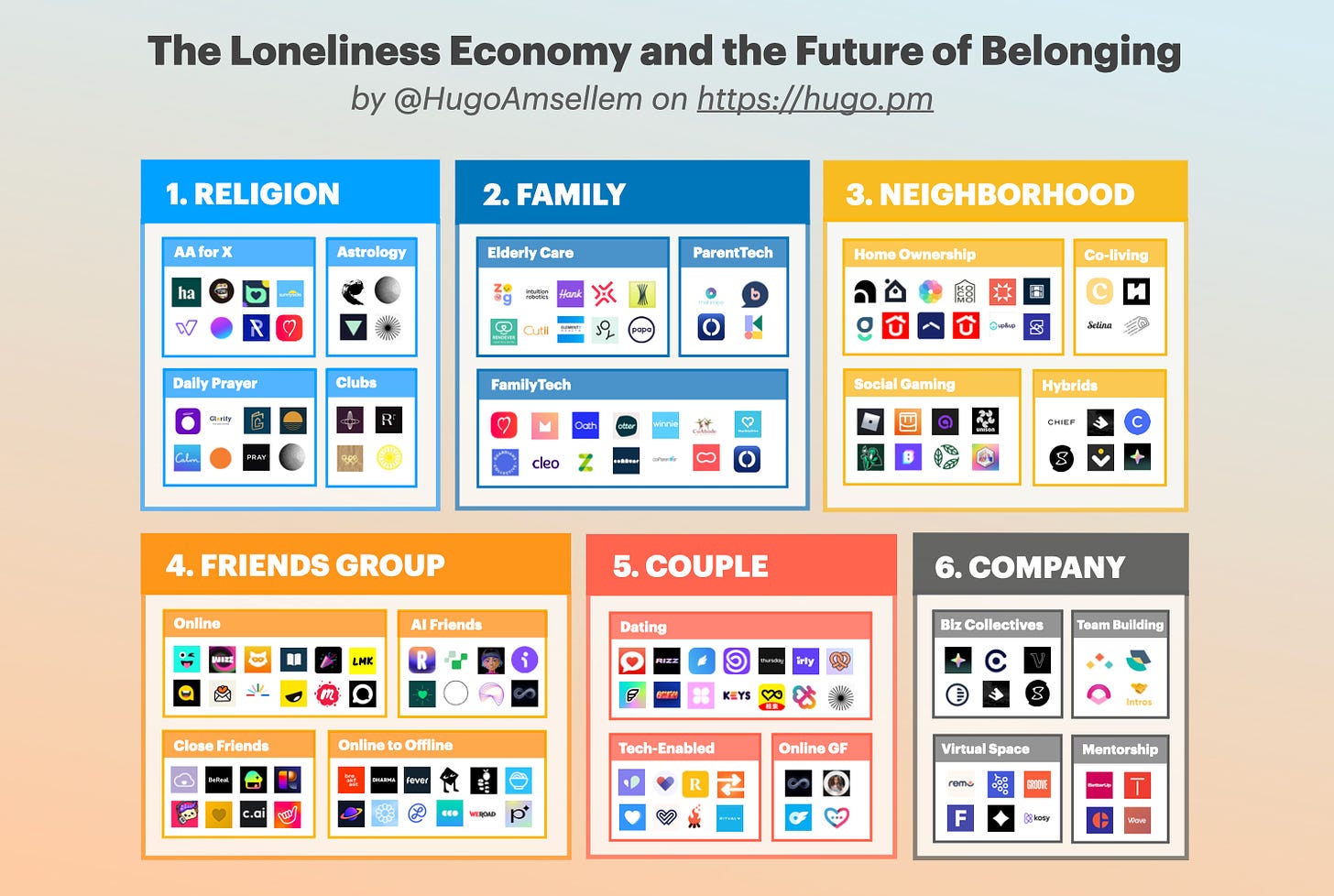
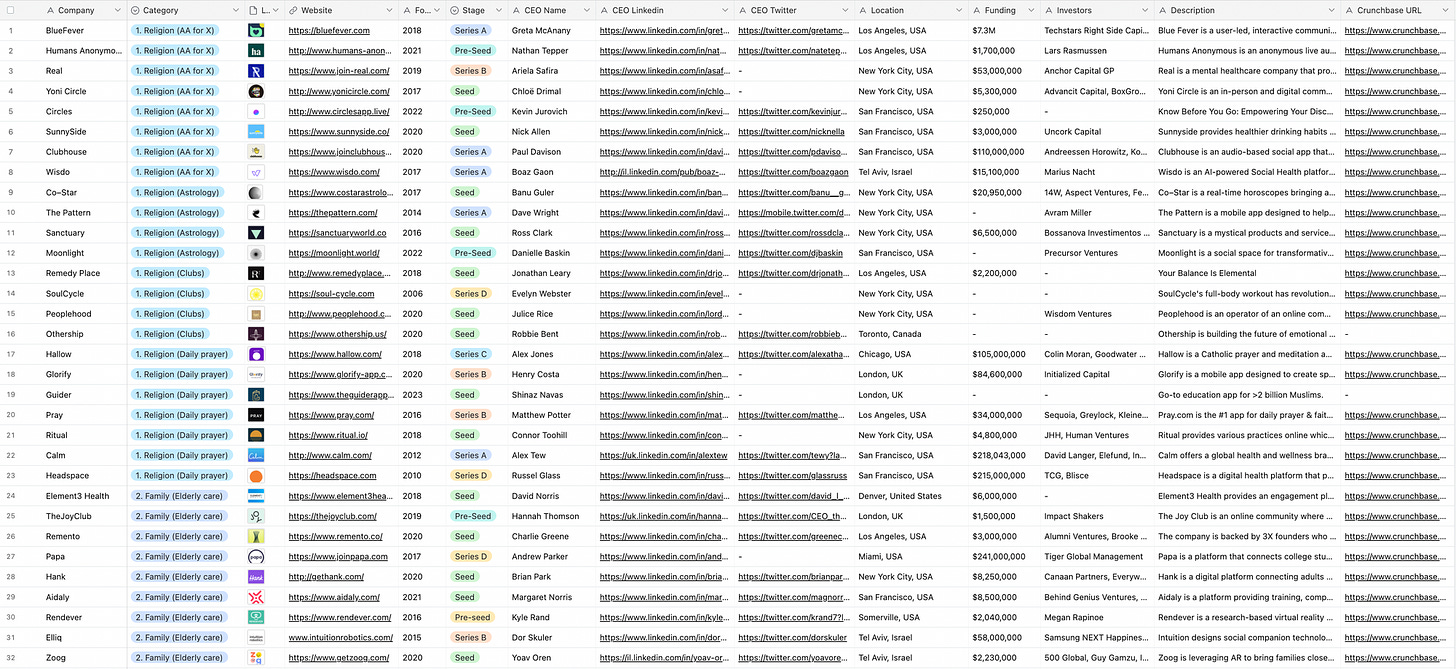
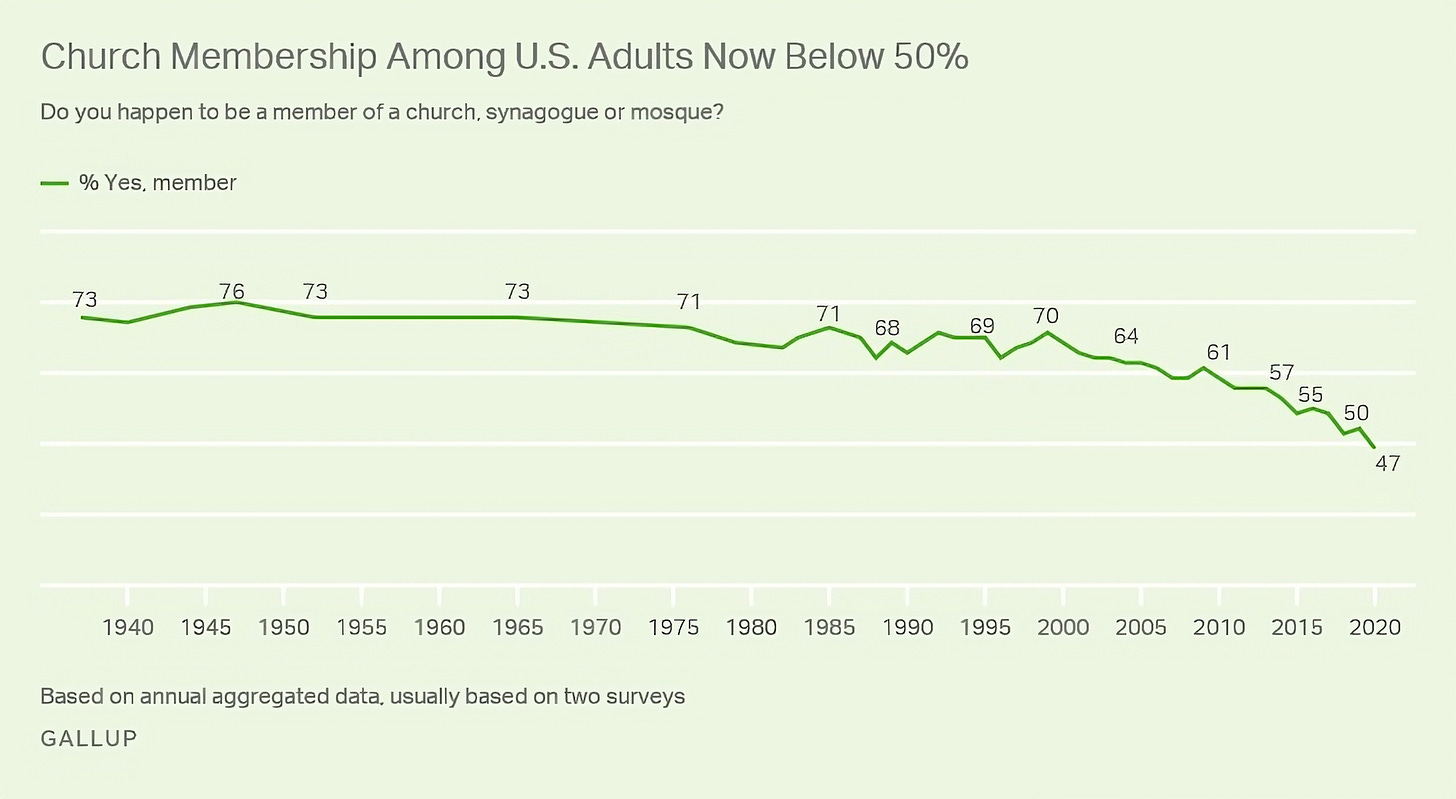
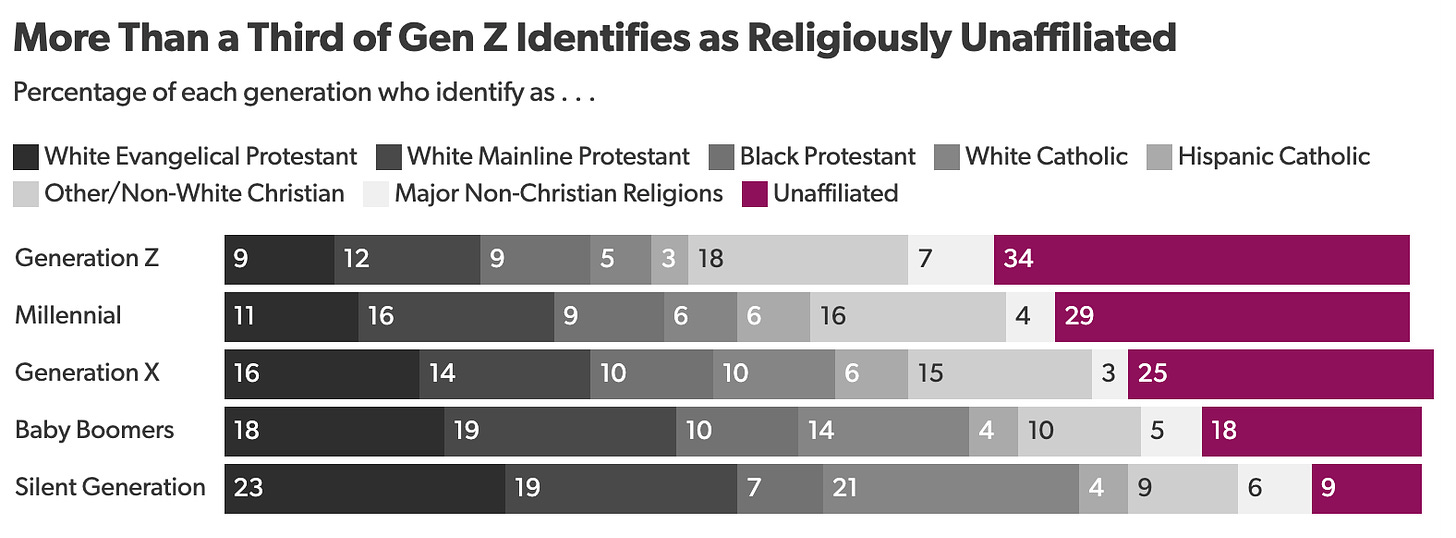
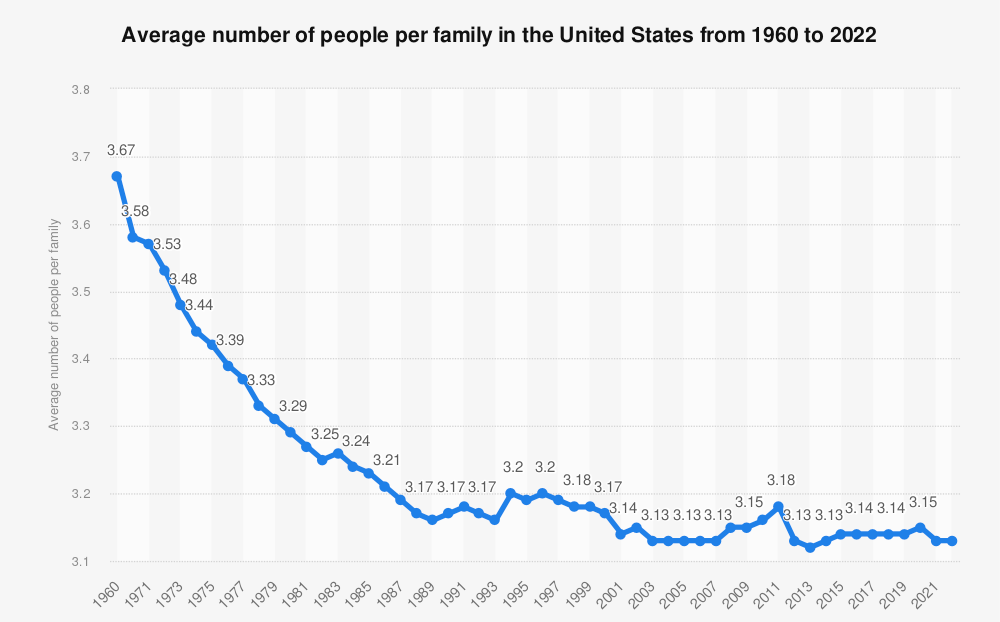
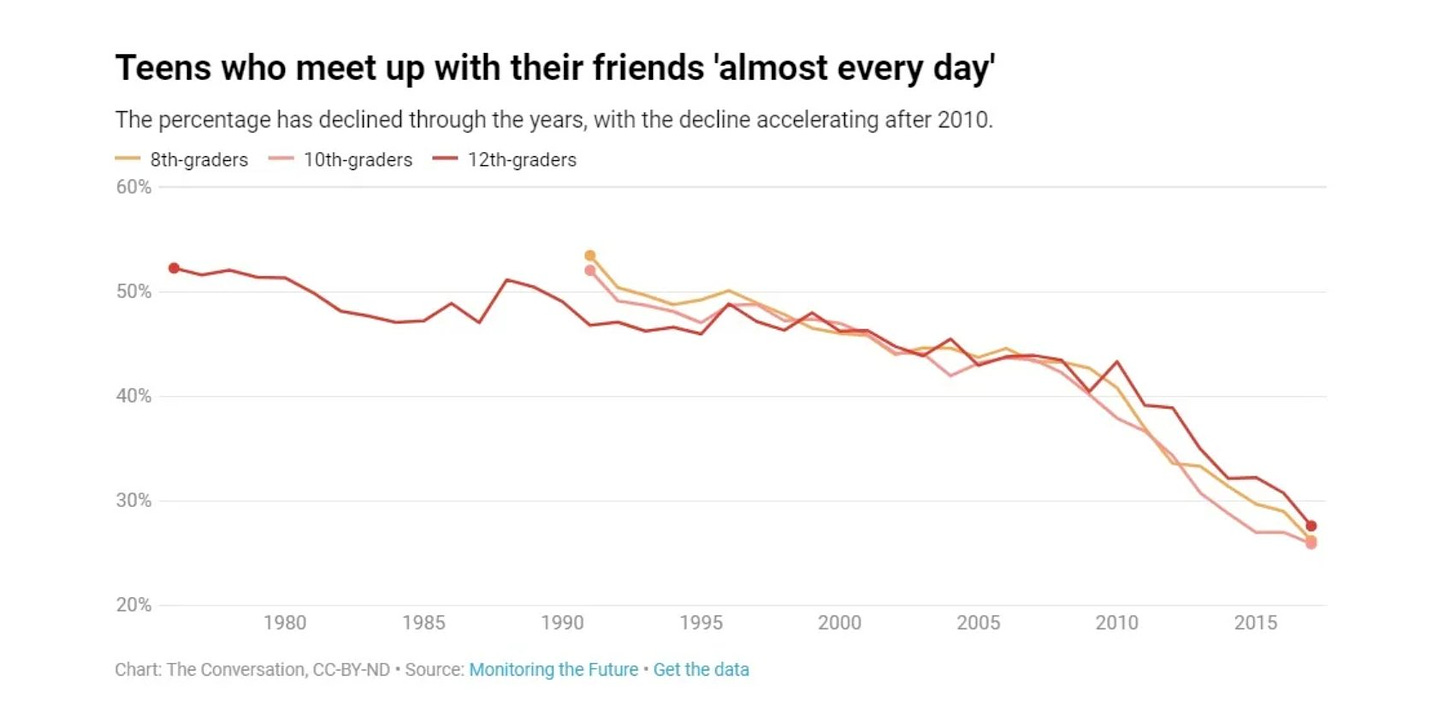
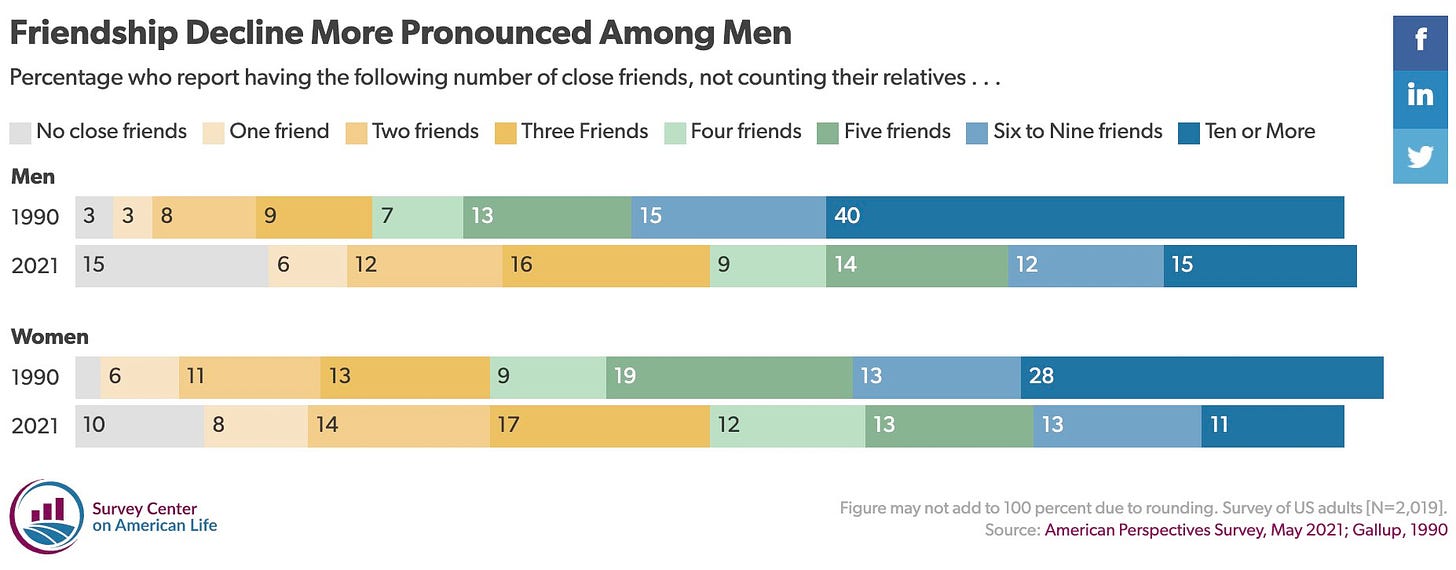
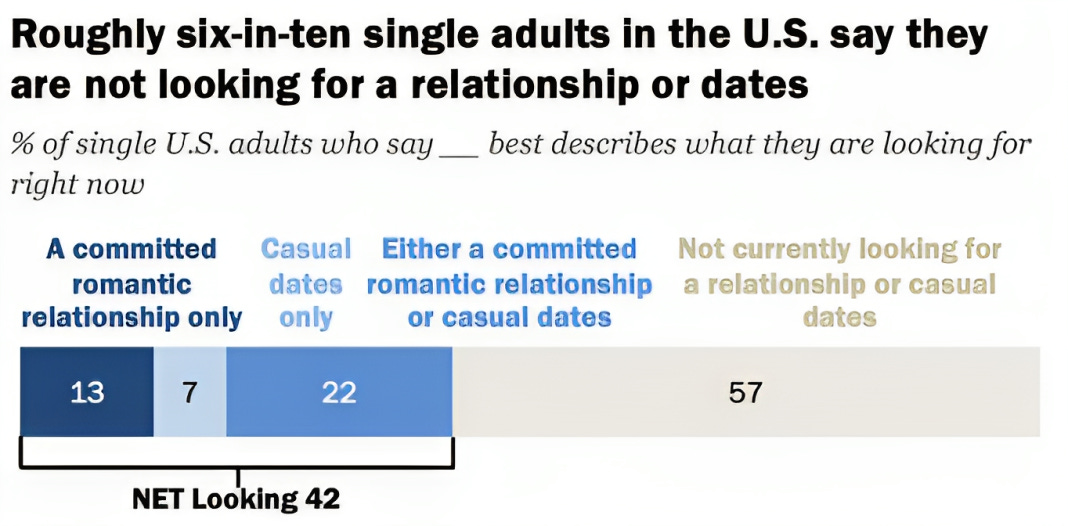
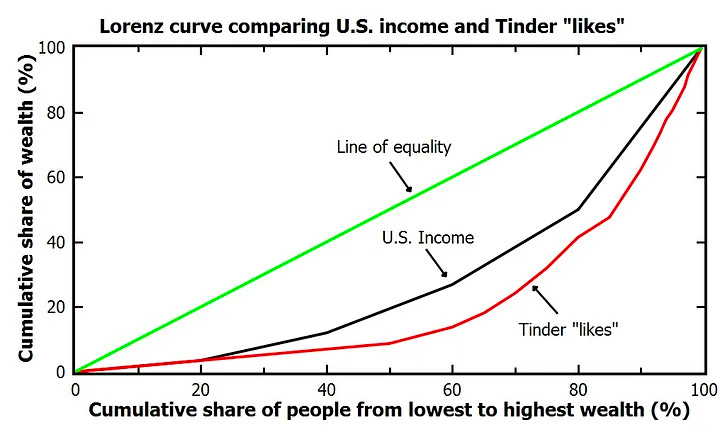
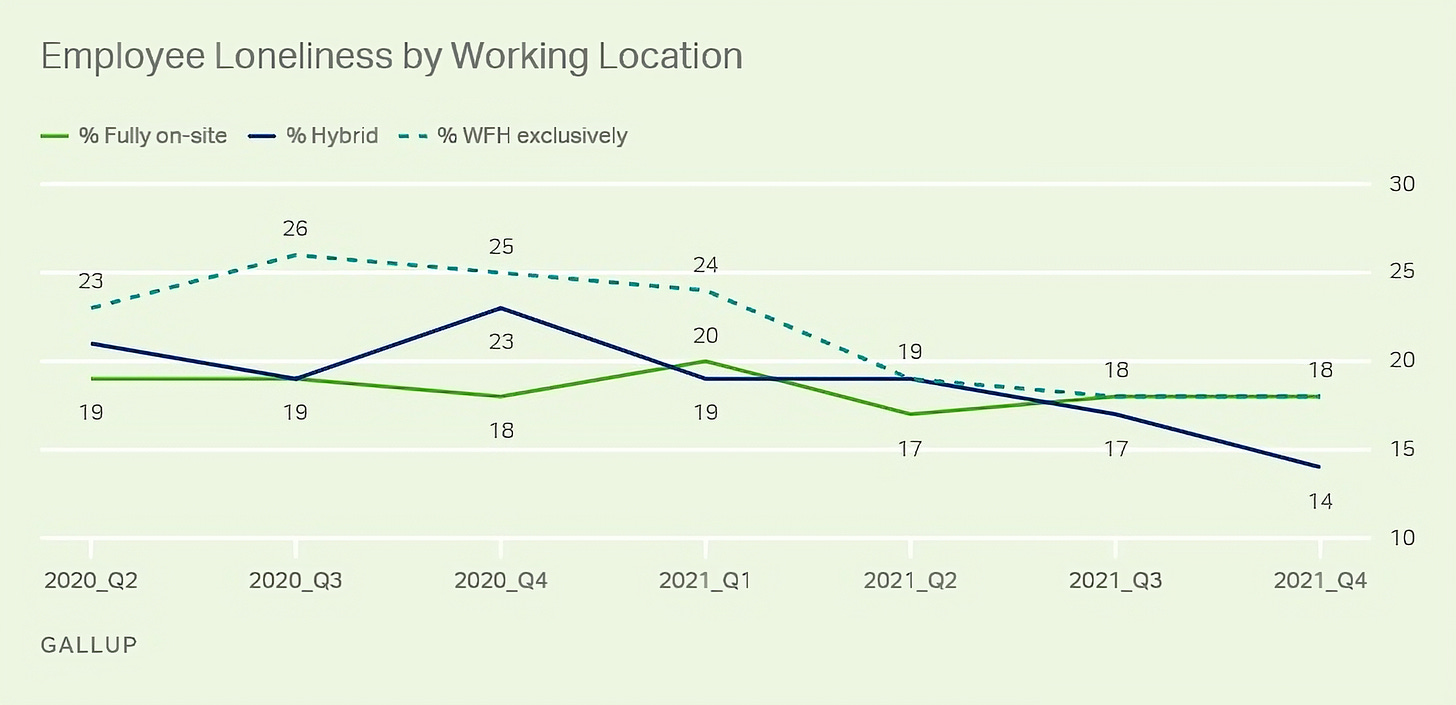
Fantastic work - thank you!
Masterpiece!